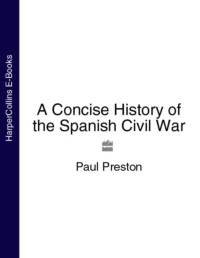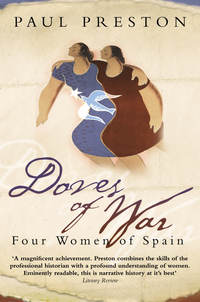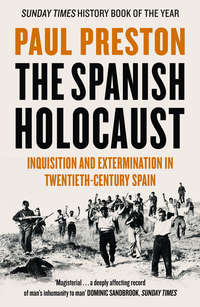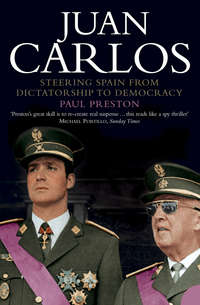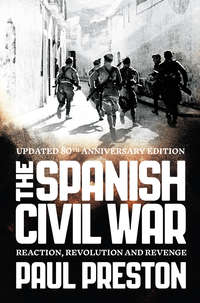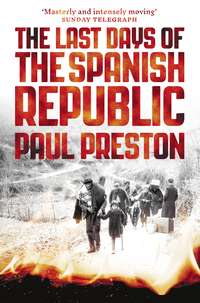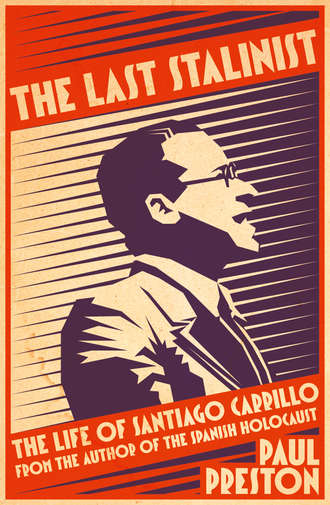
Полная версия
The Last Stalinist: The Life of Santiago Carrillo
During the night of 16 February, Carrillo and his comrades waited anxiously for the election results and news as to whether there would be an amnesty. The next morning they heard the first rumours of the Popular Front victory and the noise of a huge crowd approaching the prison. It was a demonstration demanding their release. He and the others who, like him, were still awaiting trial were freed on the evening of 17 February.45 Carrillo immediately applied for a passport to travel to Russia, which was issued on 24 February in Madrid. He was going to Moscow as part of a joint delegation of the FJS and the UJC to attend a congress of the Communist Youth International and to discuss the forthcoming unification with the leadership of the KIM. Before leaving, he had several meetings with Vitorio Codovila at the apartment of Julio Álvarez del Vayo, Araquistáin’s brother-in-law. The Comintern representative was now grooming him and chose intelligently not to reprimand him for the near-Trotskyist views expressed in Octubre: segunda etapa. Carrillo himself said later of Codovila, ‘I am indebted to him for becoming a Communist.’46
On the trip to Moscow, he was accompanied by Federico Melchor and the two UJC representatives, Trifón Medrano and Felipe Muñoz Arconada. In the Soviet capital, he was utterly bedazzled. After a year incarcerated with Largo Caballero, despite his residual affection for his father’s friend, Carrillo was beginning to suspect that the PSOE was yesterday’s party. The Socialist leadership of middle-aged men rarely allowed young militants near powerful positions in its sclerotic structures. He might be Largo Caballero’s spoilt favourite, but other senior Socialists treated him with suspicion. In Moscow, he was inspired by the sight of armed workers marching in the streets. Moreover, he was fêted as a celebrity. He described as a ‘fairy tale’ being accommodated in the luxurious Savoy Hotel and transported everywhere in a chauffeur-driven limousine to see the sights – Red Square, Lenin’s mausoleum, the Kremlin and the Bolshoi. He was even more impressed to be presented to the leaders of the Comintern, Giorgi Dimitrov and Dimitry Manuilsky, and to the secretary general of the KIM, Raymond Guyot, and his deputy, the Hungarian Mihály Farkas (‘Michael Wolf’). Barely two months after his twenty-first birthday, Carrillo was thrilled to be addressed as an equal by his heroes, especially the giant Dimitrov, who had been arrested in Berlin in March 1933 for his alleged part in the burning down of the Reichstag and then became an international hero after his courageous defence at the subsequent trial. Carrillo was entranced when Dimitrov modestly waved away talk of his exploits in the Reichstag trial. Apparently on this trip, Carrillo acquired a taste for vodka and caviar.47
He admitted later that the fusion with the UJC was merely the opening step of a project to take first the FJS and then the entire Socialist movement into the Communist International. In his submission to the KIM, he declared that the maintenance of the organizational structure of the Socialist Youth was a necessary interim measure dictated by the need first to complete the purging of the PSOE. This trip inevitably had a crucial influence on his subsequent development. The KIM, with its headquarters in Moscow, was closely invigilated by the Russian intelligence service, the NKVD (the People’s Commissariat for Internal Affairs), and Soviet Military Intelligence (Glavnoe Razvedupravlenie, or GRU). Having been identified by Codovila as a potential Comintern star, Carrillo would have been vetted anyway, but the process was probably more rigorous because of suspicions of his Trotskyist leanings reported by ‘fat Carmen’.48 Like all prospective Comintern leaders, Carrillo would have been obliged to convince his Moscow bosses, particularly the hard-line Stalinist Farkas/Wolf, that he would fully collaborate with the Soviet security services.49 It seems to have been no hardship. Seduced by Dimitrov, Manuilsky and other heroes, the young man who had presumed to argue that the FJS should dictate Socialist strategy would happily accept the diktats of the Kremlin. His first lesson was to accept that Trotsky was a traitor. The second was that the mission of a united youth movement was not to forge an elite revolutionary vanguard but to recruit a mass youth organization.
Even though it had been long coming, Carrillo’s change of position was breathtaking. He had played a significant part in encouraging the capricious and vacuous revolutionary rhetoric of Largo Caballero that had contributed to the disaster of October 1934. He had been a central figure in the project to bolshevize the PSOE and had done significant damage to the moderate and more realistic wings of the Socialist movement. Gil Robles and Salazar Alonso knew that Largo Caballero’s revolutionary threats were meaningless. In contrast, the insistent demands of Carrillo and the FJS leadership in Renovación for the conquest of power and the dictatorship of the proletariat can only have terrified moderates on the Spanish right and played into the hands of the conspiratorial extremists. The same can be said about Octubre: segunda etapa. Yet now he put all that behind him without apology or regret. He used to say in later life, ‘Repentence does not exist.’ Having contributed to the intensification of hatreds in Spain and thus weakened the Republic, he had now initiated a process that would mortally wound the party of his father and his patron. In doing so, he demonstrated a poisonous cocktail of vaulting ambition, supreme self-confidence and irresponsibility.
After the Civil War Carlos de Baraibar commented bitterly on the manic enthusiasm of Carrillo and Melchor for everything they had seen in the Soviet Union. On their return, ‘they spoke extravagantly about the people, their achievements, their laboratories and even their toilets’. He believed that, in a sense, they had been corrupted by the experience. ‘In Moscow,’ he wrote,
they, like many simple souls before them, had found their road to Damascus and, on their return, began to sketch wild plans for the reorganization of the youth movement that signified the undermining of its revolutionary essence. They brought back with them a confused mixture of totalitarian illusions of recruiting the entire young population of Spain, ambition to create a colossal organization and sheer village idiocy. They were seduced by the bewildering panoply of figures, tables and statistics cleverly put before them.50
Shortly after Carrillo’s return to Madrid, a joint meeting was held of the FJS and UJC executive committees to consider the report that the delegation had elaborated in Moscow in favour of a new mass united movement. The report was approved as the basis for unification and a joint national committee set up to implement the fusion process. Much effort had been made to combat suspicions that the Socialist movement was about to lose its youth movement to the Communists. Rather, it was hoped to reassure Largo Caballero that the UJC would be absorbed into the FJS. However, in practice, as could have been anticipated, that was not what happened, given Carrillo’s ever closer links to Moscow. Public meetings were held in local sections of both organizations to propagate the unification. They culminated in a mass gathering at the Las Ventas bull-ring in Madrid on Sunday 5 April 1936. In his speech on that occasion, Carrillo declared that what was happening repaired the schism of 1921 which had seen the radical wing of the PSOE depart to form the PCE. The event at Las Ventas was followed throughout May and July 1936 by meetings of the provincial sections of the FJS and UJC to prepare for a great national conference of unification which, because of the outbreak of civil war, never took place. In those months, the joint membership of 100,000 was swollen to 140,000.51
Retrospectively, Largo Caballero recalled his reaction in similar terms to those of Baraibar. He claimed that when Carrillo and others came to explain the proposed organizational plans, he told them that their plans for a mass youth movement undermined the purpose of the FJS as an elite training school for future PSOE leaders. He declared uncompromisingly that he now considered the FJS to be dead and, with it, the hope that it would be a bulwark for the Socialist Party. Carrillo tried to convince him of his good faith and his loyalty. He made ‘a solemn promise that he would create a formidable organization that was totally socialist’.52
Amaro del Rosal, who was one of those present when Largo Caballero was informed of the unification, recalled his distress: ‘his eyes filled with tears’. Carrillo had effectively delivered a shattering blow to the PSOE, undermining its political future. As Largo Caballero perceived, he was delivering to the PCE, in the words of Helen Graham, ‘a political vanguard which undoubtedly included many potential national and provincial leaders’. There were those, Serrano Poncela among them, who were alarmed that Carrillo now talked of creating a mass organization contrary to the traditional perception of the FJS as an elite training ground for the PSOE. Although Carrillo made a speech in which he paid tribute to Largo Caballero, the damage had been done.53
Carrillo took part in a meeting of the Communist Party Central Committee on 31 March, at which he suggested that the new JSU, the Juventudes Socialistas Unificadas, should seek membership of the KIM and that the PSOE should unite with the PCE and join the Comintern. Attendance at Central Committee meetings was a privilege not normally extended to outsiders.54 Carrillo would not formally join the Communist Party for another six months, but there is reason to believe that he was already a Communist in all but name. In 1974, he admitted that, on his return from Moscow, ‘I had begun to become a Communist. I did not join the Party immediately, although I began to collaborate with the Communists and was even invited to take part in meetings of the Central Committee. I had not yet joined because I was still hopeful of bringing about the unification of the Socialist and Communist parties.’55
The procedure whereby the new executive committee of the JSU was appointed in September 1936 was extremely opaque. There were fifteen members, of whom seven were Communists, although several of the eight Socialists were so close to the PCE as made little difference. Carrillo became secretary general of an organization that, despite its name, constituted a massive advance of Communist influence.56 Those who perceived the creation of the Juventudes Socialistas Unificadas as the loss of the FJS to the Third International coined the nickname ‘Juventudes Socialistas Urssificadas’ (USSR in Spanish being URSS).57
When the military coup in Spain began on 18 July, Carrillo was in Paris where he had gone with Trifón Medrano and José Laín Entralgo to discuss with Raymond Guyot, the secretary general of the Communist Youth International, the problems posed by the meeting in Madrid with the comical German woman delegate of the Comintern, Carmen. In his memoirs, he recounted his heroic response to hearing of the military coup. In this version, for which there is no corroboration, all three immediately set off for the border. Crossing into Spain at Irún, they headed for San Sebastián and immediately got involved in an assault on an hotel where some rebel supporters had barricaded themselves in. Later, in a vain effort to reach Madrid, Carrillo and his companions spent some weeks fighting on the Basque front with a unit organized by the Basque Communist Party. Being extremely short-sighted, Carrillo was anything but a natural soldier. Eventually, they were able to cross into France and then back into Spain via Puigcerdà. The Communist veteran Enrique Líster claimed that the entire account was pure invention and that, during this period, Carrillo remained in Paris. Whatever the truth, it is clear that already, in those early weeks of the war, he was convinced that the only party with the sense of direction to take control of events was the PCE.58
When he got back to Madrid at the beginning of August, the JSU was already trying to turn its pre-war militia structure into proper fighting units. Carrillo claims that he was made political commissar of the JSU’s ‘Largo Caballero’ battalion which was fighting in defence of the city in the sierras to the north. His heroic picture of that period of his life is somewhat undermined by Manuel Tagüeña, a much more reliable witness, who suggested that Carrillo was involved in political rivalries that undermined the efforts of the Italian Fernando De Rosa to link the various units.59 Certainly, his military career, if it took place at all, was brief. Given the vertiginous growth of the JSU, it was clear that Carrillo could be of most use in a political rather than a military capacity.
The JSU was being inundated with new recruits and soon had more militants than the adult membership of the PSOE and PCE combined.60 At every level of society, the economy and the war effort, in industry and the nascent armed forces, JSU members were playing a key role. Accordingly, Carrillo was now working in Madrid on the practicalities of consolidating Communist control over this powerful new instrument. After prolonged hesitation, on 4 September 1936 Largo Caballero finally succumbed to Prieto’s arguments that the survival of the Republic required a cabinet backed by the working-class parties as well as the bourgeois Republicans. A true Popular Front government was formed in which Largo Caballero was both Prime Minister and Minister of War. It contained Communists as well as Socialists and Republicans. Two months later, on 4 November, with the Nationalist rebels already at the gates of Madrid, four representatives of the anarcho-syndicalist CNT would also join the cabinet.
By then, rebel air raids were intensifying. Far from undermining the morale of the Madrileños, they did the opposite and provoked a deep loathing of the self-styled ‘Nationalists’. Virtually every left-wing political party and trade union had established squads to eliminate suspected fascists. With their tribunals, their prisons and their executioners, they were known loosely as checas. Their targets were those assumed to be rebel supporters within the capital. This included both imprisoned and as yet undetected right-wingers, all of whom in the frantic conditions of the besieged capital were indiscriminately regarded as ‘fifth columnists’. The name was inadvertently coined by General Mola, who in early October had infamously stated that he had four columns poised to attack Madrid but that the attack would be initiated by a fifth column already inside the city.61 On the basis of the massacres perpetrated in southern Spain by Franco’s African columns, it was believed that the rebels planned to kill anyone who had been a member of any party or group linked to the Popular Front, held a government post or was an affiliate of a trade union. Spine-chilling broadcasts from Seville made by General Gonzalo Queipo de Llano propagated fear and hatred.
In the claustrophobia generated by the siege, popular rage focused on the prison population. Among those detained were many who were considered potentially very dangerous. As rebel columns came ever nearer to the capital throughout October, there was growing concern about the many experienced right-wing army officers who had refused to honour their oath of loyalty to the Republic. These men boasted that they would form new units for the rebel columns once they were, as they expected, liberated. Anarchist groups were already randomly seizing prisoners and shooting them. On 4 November, Getafe to the south of Madrid fell and the four anarchist ministers joined the government. Advancing through the University City and the Casa de Campo, by 6 November the rebels were only 200 yards from the largest of the prisons, the Cárcel Modelo, in the Argüelles district.
In this context, the decision that Largo Caballero’s cabinet should leave for Valencia was finally taken in the early afternoon of 6 November. The two Communist ministers in the government, Jesús Hernández (Education) and Vicente Uribe (Agriculture), had argued the Party line that, even if the government had to be evacuated, Madrid could still be defended.62 General José Miaja Menent, head of the 1st Military Division, that is to say, Military Governor of Madrid, was placed in charge of the defence of the capital and ordered to establish a body, to be known as the Junta de Defensa, which would have full governmental powers in Madrid and its environs. In fact, Largo Caballero and the fleeing cabinet believed that the capital was doomed anyway. In their view, the Junta was there merely to administer its surrender. Indeed, when Largo Caballero informed him of his new responsibilities, Miaja turned pale, sure that he was being sacrificed in a futile gesture.63 Whether or not that was the intention, Madrid would survive the siege for another twenty-nine months.
Until the battle for the capital was resolved, Miaja’s awesome task was to organize the city’s military and civil defence at the same time as providing food and shelter for its citizens and the refugees who thronged its streets. In addition, he had to deal with the violence of the checas and the snipers and saboteurs of the ‘fifth column’.64 The Junta de Defensa would thus be a localized mini-government made up of ‘ministers’ (whose title was Councillor – Consejero) chosen from all those parties that made up the central government. However, Miaja would turn first to the Communists in search of help. And they were ready and waiting.
The two Communist ministers had immediately reported the cabinet’s decision to the PCE top brass, Pedro Fernández Checa and Antonio Mije. They were effectively leading the Party in the frequent absences of the secretary general, José Díaz, who was seriously ill with stomach cancer. Pedro Checa was already collaborating closely with the NKVD.65 The implications were discussed and plans made. Astonishingly, present at this historic meeting were Santiago Carrillo and José Cazorla, who were both, theoretically at least, still members of the Socialist Party. Their presence demonstrates the enormous importance of the now massive JSU and also suggests that they were already in the highest echelons of the PCE.
Late in the afternoon, Checa and Mije went to negotiate with Miaja the terms of the Communist participation in the Junta de Defensa. A grateful Miaja eagerly accepted their offer that the PCE run the two ‘ministries’ (consejerías) of War and Public Order in the Junta de Defensa. He also accepted their specific nominations of Antonio Mije as War Councillor and of Carrillo as Public Order Councillor with Cazorla as his deputy. While Mije and Checa were negotiating with Miaja, Carrillo and Cazorla had gone to ask Largo Caballero for a statement to explain to the people of Madrid why the government was leaving. The Prime Minister denied that the government was being evacuated, despite the suitcases piled outside his office. Further disillusioned by the lies of their already broken hero, Carrillo and Cazorla went back to the Central Committee of the PCE.66
At about eight in the evening, Mije and Carrillo went to see Miaja to discuss their future roles. Shortly before his death, in discussing the Spanish edition of my book The Spanish Holocaust, Carrillo claimed that, at the end of this meeting, he had asked Miaja what he was expected to do about the fifth column and that the General had replied, ‘Smash it.’ In this account, Miaja allegedly said that victory would go to the army that annihilated the other and that this would be done with bullets and bayonets. He said that the fifth column must be prevented at all costs from attacking from behind. Looking at Carrillo, he said, ‘That is your job and you will have our help.’ It is curious that, in his innumerable statements about his role in the executions of right-wing prisoners in Madrid, Carrillo had never previously mentioned Miaja. In The Spanish Holocaust reference was made to a later Republican police report on collaboration between NKVD agents and the public order apparatus, an ambiguity of whose wording raised the possibility that Miaja may have approved of Carrillo’s activities. That Carrillo should seize upon this was a way of saying that, whatever he did subsequently, he was only obeying orders.67 There is an irony about this, since elsewhere he denied all knowledge of the massacres committed on his watch.
In Carrillo’s own words, ‘on that same night of 6 November, I began to discharge my responsibilities along with Mije and others’.68 He was able to nominate his subordinates in the Public Order Council and assign them tasks immediately after this meeting with Miaja late on the night of 6–7 November. He set up a sub-committee, known as the Public Order Delegation, under Serrano Poncela, who was effectively given responsibility for the work in Madrid of the Dirección General de Seguridad, the national police headquarters. The Delegation was taking decisions from the very early hours of 7 November.69 The anarchist Gregorio Gallego highlighted the Communists’ ability to hit the ground running: ‘we realized that the operation was far too well prepared and manipulated to have been improvised’.70
Overall operational responsibility for the prisoners lay with three men: Carrillo, Cazorla and Serrano Poncela. They took key decisions about the prisoners in the vacuum between the evacuation of the government late on the night of 6 November and the formal constitution of the Junta de Defensa twenty-four hours later. However, it is inconceivable that those decisions were taken in isolation by three inexperienced young men aged respectively twenty-one (Carrillo), thirty (Cazorla) and twenty-four (Serrano Poncela). The authorization for their operational decisions, as will be seen, had to have come from far more senior elements. Certainly, it required the go-ahead from Checa and Mije who, in turn, needed the approval of Miaja and of the Soviet advisers, since Russian aid in terms of tanks, aircraft, the International Brigades and technical expertise had started to arrive over the previous weeks. How much detail, other than airy references to ‘controlling the fifth column’, Miaja received is impossible to say. The implementation of the operational decisions also required, and would get, assistance from the anarchist movement.
Thus the authorization, the organization and the implementation of what happened to the prisoners involved many people. However, Carrillo’s position as Public Order Councillor, together with his later prominence as secretary general of the Communist Party, saw him accused of sole responsibility for the deaths that followed. That is absurd, but it does not mean that he had no responsibility at all. The calibration of the degree of that responsibility must start with the question of why the twenty-one-year-old leader of the Socialist Youth was given such a crucial and powerful position. Late on the night of 6 November, after the meeting with Miaja, Carrillo, along with Serrano Poncela, Cazorla and others, was formally incorporated into the Communist Party. They were not subjected to stringent membership requirements. In what was hardly a formal ceremony, they simply informed José Díaz and Pedro Checa of their wish to join and were incorporated into the Party on the spot. The brevity of the proceedings confirms that Carrillo was already an important Communist ‘submarine’ within the Socialist Party. After all, he had brought into the PCE’s orbit the 50,000 members of the FJS and the further 100,000 who had subsequently joined the JSU. He was already attending meetings of the PCE’s politburo, its small executive committee, which indicated that he was held in high esteem. He had long since been identified by Comintern agents as a candidate for recruitment. If he had not publicly made the switch before, it was because of his, and presumably their, hope that he could help bring about the unification of the PSOE and the PCE. Largo Caballero’s determined opposition to unity combined with his poor direction of the war effort had made this seem a futile aspiration. Moreover, the prestige accruing to the Communist Party from Soviet aid suggested that there was little advantage in delaying the leap. It was an eminently practical decision, although Fernando Claudín argued implausibly that Carrillo was brave to sever his links with a party within which he was so prominently placed.71


